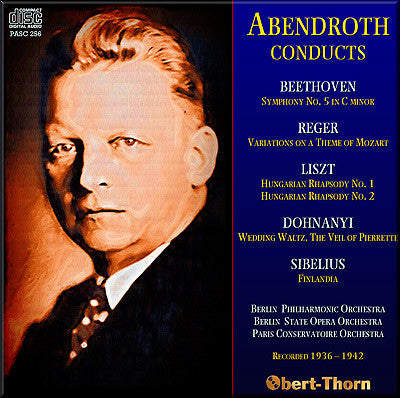
This album is included in the following sets:
This set contains the following albums:
- Producer's Note
- Full Track Listing
- Cover Art
From Beethoven to Sibelius - a fine, wide-ranging collection
French and German orchestral recordings transferred by Mark Obert-Thorn
Abendroth’s Beethoven Fifth was set down during the same month that Furtwängler’s classic prewar HMV set was completed, and featured the same orchestra. It has been transferred here from British Parlophone shellacs. The rare wartime Paris set of the Reger Mozart Variations (presented as issued, sans Fugue) was, rather unusually, recorded by Odeon for release on French HMV. The dim, hissy sound is inherent in the original recording, although I have tried to bring out as much detail as exists in the shellacs. The first Liszt Hungarian Rhapsody came from a laminated Australian Parlophone disc, while the remaining items were transferred from German Odeon pressings. Some inner-groove distortion will be noticeable due to the high recording volume levels at the ends of the works.
Mark Obert-Thorn
-
BEETHOVEN: Symphony No. 5 in C minor, Op. 67
Berlin Philharmonic Orchestra
Recorded 22nd November, 1937 in Berlin
Matrix nos.: xxNSK 23, 24, 25, 26, 27-2, 28, 29 and 30
First issued on Odeon O-7898 through 7901
-
REGER: Variations on a Theme of Mozart, Op. 132
Orchestre de la Société des Concerts du Conservatoire, Paris
Recorded 6th May, 1942 in Paris
Matrix nos.: 2LA 3664-1, 3665-1, 3666-1 and 3667-1
First issued on Disque Gramophone DB 5197 and 5198
-
LISZT (arr. Müller/Berghaus): Hungarian Rhapsody No. 1
Berlin State Opera Orchestra
Recorded 19th June, 1937 in the Philharmonie, Berlin
Matrix nos.: xxB 8617 and 8618
First issued on Odeon O-7734
-
LISZT (arr. Müller): Hungarian Rhapsody No. 2
Berlin Philharmonic Orchestra
Recorded 1st October, 1938 in the Philharmonie, Berlin
Matrix nos.: xxB 8575 and 8576
First issued on Odeon O-7887
-
DOHNÁNYI: Wedding Waltz from The Veil of Pierrette (Ballet Suite)
Berlin State Opera Orchestra
Recorded 19th June, 1937 in the Philharmonie, Berlin
Matrix nos.: Be 11723 and 11724
First issued on Odeon O-4759
-
SIBELIUS: Finlandia, Op. 26
Berlin State Opera Orchestra
Recorded 2nd October, 1936 in Berlin
Matrix nos.: xxNSK 14 and 15
First issued on Odeon O-7896
Hermann Abendroth, conductor
Producer and Audio Restoration Engineer: Mark Obert-Thorn
Cover artwork based on a photograph of Hermann Abendroth
Total duration: 77:45
Fanfare Review
A valuable collection, and a real treat for connoisseurs of historic conducting.
This enterprising collection brings together prewar German Odeon recordings (1936–38) with rare wartime Paris sessions (HMV, 1942). The 1937 Beethoven Fifth has been available on Tahra (though the new transfer is superior), but so far as I’m aware the rest is new to CD.
The first movement of the Beethoven (played without exposition repeat) is characteristically feisty, eager and thrusting, with considerable rhetorical underlining of the motto. Odeon’s recorded balance is not ideal—rather too violin-dominated, though the elegantly turned violin playing throughout (e.g., in the second theme) is certainly worth drawing attention to. Beginning with an exaggeratedly elongated upbeat, the Andante con moto is slow and rather romanticized, the cello theme free, the contrasting theme rather portentous in the “Old School” way (interestingly, not subscribed to by all prewar maestros—for example, Richard Strauss [Berlin State Opera Orchestra, 1928] and Mengelberg [Concertgebouw, 1937], who go out of their way to stress forward momentum here). Abendroth’s Scherzo begins slowly, accelerating to a fast, light treatment before slamming on the brakes for the Trio. The finale is played with real brio and panache, along with an occasional penchant for theatrically underlined gestures (see the horns’ melody, bars 26 ff.—again, interesting to observe Mengelberg doing just the opposite, by slowing down before, then playing the tune in tempo). The second theme is given an attractively buoyant, scherzando treatment (bars 45 ff.), and climactic passages (end of the development; coda) surge excitingly, with a heady exuberance.
The obvious comparisons are two other classics from the same year: Mengelberg’s Telefunken recording, cited above—altogether more weight, power, intellect, articulacy, and discipline; and Furtwängler’s famous HMV version, made with the Berliners in the same month as Abendroth (11/1937)—smooth, sleek, and dashing, at tempos close to Abendroth’s, and faster than his own preserved later versions. On the whole, the slightly younger maestro’s interpretation (Furtwängler was Abendroth’s junior by three years) is both grander and more subtle in its tempo modification, as well as better played and recorded.
Reger’s Mozart Variations (curiously minus their concluding fugue, which seems not to have been recorded) are cogently shaped at lively tempos, the French orchestral sound imparting a pungent, acidic edge that cuts through Reger’s thick textures—altogether quite a contrast with the sweet, highly inflected account from Böhm/Dresden Staatskapelle (Electrola, 1938/Lys) and the cultivated elegance of van Beinum/Concertgebouw (Polydor, 1943/Music & Arts). The wartime recording is far from ideal, cut at a low level with heavy surface noise. Abendroth directs the Liszt rhapsodies with idiomatic dash and panache, whipping up real excitement with a virtuoso response from both orchestras. Odeon’s reverberant recordings are short on detail, but tuttis are satisfyingly full and rich. Dohnányi’s Wedding Waltz is an attractive mix of Strauss (Johann), Wagner, and a touch of neoclassical harmonic astringency spiced with Hungarian paprika; the performance has irresistible Schwung. The Sibelius is briskly efficient but of no special insight; contemporary versions from Beecham (LPO, 1938/Naxos) and Rodzinski (Cleveland, 1939/Lys) are better played and more individual—the former imposingly grand, the latter an amazingly original conception, light and punchy.
Mark Obert-Thorn’s transfers are impressive, as always, in bringing out the best from this motley crew of often recalcitrant originals. A valuable collection, and a real treat for connoisseurs of historic conducting.
Boyd Pomeroy
This article originally appeared in Issue 34:5 (May/June 2011) of Fanfare Magazine.

